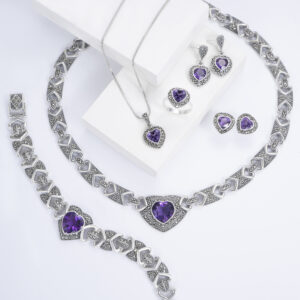Finding reliable suppliers is one of the most critical steps in building a successful marcasite jewelry business. Because marcasite jewelry requires meticulous hand-setting, high-purity silver, and precise oxidation and finishing, choosing the wrong supplier can result in poor craftsmanship, loose stones, inconsistent quality, and costly returns. Low-quality suppliers can harm your brand reputation, drain your finances, and derail long-term growth.
This detailed 1,200-word guide explains how to avoid low-quality suppliers in the marcasite jewelry industry, especially when sourcing from global markets. By following this checklist, you can protect your business and ensure that your jewelry collection maintains top-tier quality. Titanium earrings for sensitive ears
1. Verify the Supplier’s Experience in Marcasite Jewelry

Marcasite jewelry is very different from standard silver jewelry. It requires hand-set stones, micro-prong techniques, and delicate craftsmanship.
Look for suppliers who:
- Have 10+ years of experience
- Specialize specifically in marcasite (not just silver)
- Employ skilled artisans, particularly from Thailand
Suppliers without real expertise often produce pieces with misaligned stones and weak prongs.
2. Request Physical Samples Before Ordering
This is the most effective way to identify poor suppliers.
What samples reveal:
- Stone security (should never wobble)
- Precision in micro-prong settings
- Silver purity and weight
- Polishing quality
- Symmetry and finishing
If a supplier hesitates to send samples, treat it as a red flag.
3. Examine Stone-Setting Quality Carefully
Low-quality marcasite jewelry often has:
- Crooked stones
- Visible glue (a major sign of poor quality)
- Uneven stone sizes
- Gaps or loose prongs
High-quality stone setting:
- Uses no glue whatsoever
- Employs hand-set micro-prongs
- Achieves consistent alignment and shine
Poor stone-setting leads to high return rates and unhappy customers.
4. Confirm Silver Purity and Metal Standards
Low-quality suppliers frequently use:
- Low-purity silver
- Nickel or mixed alloys
- Improperly treated metals prone to tarnishing
Reliable suppliers use:
- 925 sterling silver
- 95–98% Thai silver (for handcrafted designs)
- Nickel-free alloys
Always ask for certificates or stamped markings.
5. Evaluate the Supplier’s Production Capacity
A common issue with low-quality suppliers is the inability to handle consistent bulk orders.
Ask about:
- Monthly production volume
- Average lead times
- Peak season capacity
- Number of skilled artisans on staff
Suppliers who overpromise often deliver poor quality under pressure.
6. Inspect Finishing Techniques
Finishing impacts the final appearance and durability.
Signs of poor finishing:
- Sharp edges
- Uneven oxidation
- Rough surfaces
- Visible solder marks
Signs of high-quality finishing:
- Smooth, polished edges
- Consistent oxidation tones
- Clean detailing in filigree and patterns
Finishing mistakes are easy to spot and hard to fix.
7. Ask About Quality Control (QC) Procedures
Low-quality suppliers often skip QC entirely.
A professional supplier should have:
- Multi-stage QC inspection
- Stone security testing
- Silver purity checks
- Final pre-shipment reviews
Strong QC prevents defects from reaching customers.
8. Look for OEM/ODM Capabilities
Suppliers who provide OEM (custom design) and ODM (ready-made design) services typically have better manufacturing infrastructure.
Benefits:
- Design consistency
- Ability to create custom pieces
- Access to CAD modeling and prototyping
Low-quality suppliers usually cannot support custom designs effectively.
9. Analyze Communication Speed and Clarity

Communication reflects professionalism.
Warning signs:
- Slow replies
- Vague answers
- Poor English communication
- Refusal to provide details
Clear communication is essential to avoid production errors.
10. Check Company Legitimacy and Background
Low-quality suppliers often lack proper registration.
Verify:
- Business registration documents
- Export history
- Online presence and reviews
- Physical address and workshop photos
Legitimate suppliers are transparent—scammers are not.
11. Review Customer Feedback and Testimonials
Look for real reviews from established businesses.
Signs of a trustworthy supplier:
- Long-term client relationships
- Positive feedback on consistency
- Testimonials highlighting stone-setting quality
Negative or vague reviews are clear red flags.
12. Inspect Packaging Standards
Low-quality suppliers often use inadequate packaging, risking damage during shipping.
Good packaging includes:
- Anti-tarnish bags
- Bubble wrap
- Divider trays for brooches, rings, earrings
- Strong outer cartons
Poor packaging can cause stone loss or scratches.
13. Compare Prices Carefully
Extremely low prices usually indicate:
- Fake marcasite stones
- Low-purity silver
- Machine-set stones with glue
- Poor craftsmanship
Fair pricing reflects the cost of skilled labor and quality materials.
14. Avoid New Suppliers With No History in Marcasite
Marcasite jewelry requires specialized skills.
Avoid suppliers who:
- Just started producing marcasite
- Have no portfolio or catalog
- Offer overly modern designs unrelated to marcasite tradition
Experience is everything in this niche.
15. Prefer Thai Manufacturers for Highest Quality
Thailand is the world leader in handcrafted marcasite jewelry.
Reasons:
- Highly skilled artisans
- Strong silverwork heritage
- Consistent large-scale production
- Ethical labor standards
- Accurate and durable stone-setting
Trusted manufacturers like Hong Factory produce premium marcasite jewelry for global brands.
Final Thoughts
Avoiding low-quality suppliers in the marcasite jewelry industry is essential for protecting your brand, margins, and long-term success. By evaluating stone-setting quality, silver purity, finishing techniques, communication, and production capability, you can confidently distinguish reliable suppliers from unreliable ones.
Sourcing from experienced manufacturers—especially in Thailand—ensures you receive high-quality, handcrafted marcasite jewelry that meets global standards.
Choosing the right supplier is not just a business decision—it’s the foundation of your brand’s reputation.
